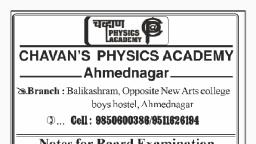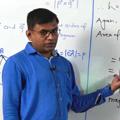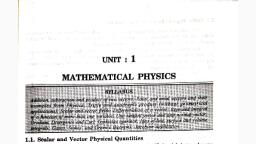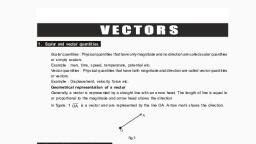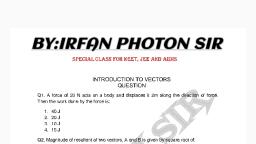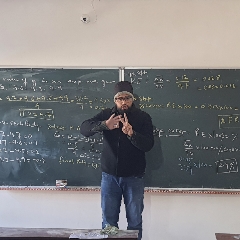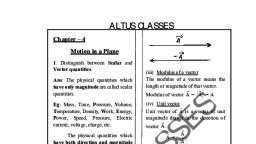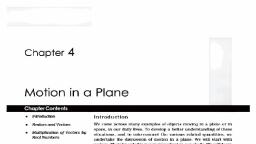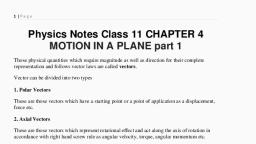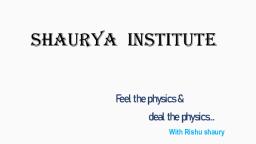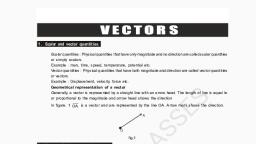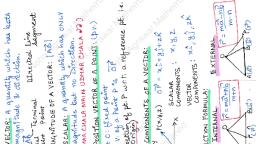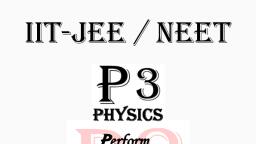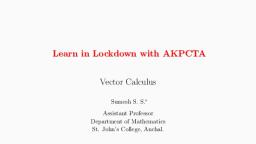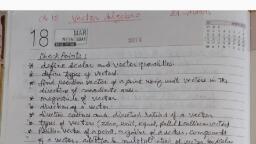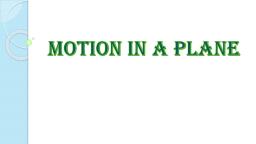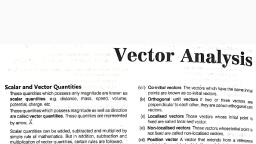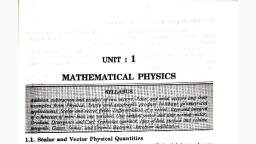Page 1 :
inside, , Scalar and vector quantities, , * General points regarding vectors, , * Types of vectors., , * Multiplication and division of, vectors by scalars, , Addition of two vectors, , Subtraction of two vectors, * Resolution of vectors, * Position vector and, displacement vector, 4 Product of lwo vectors, “Sealy product of two vectors, Veetor product of two vectors, , Vectors, , In physics, we study a large number of physical quantities. These physical quantities, can either have magnitude or magnitude and direction both. On this basis, we have, broadly categorised physical quantities into two categories : scalars and vectors. In, , this chapter, we will study about the vector quantities and their operations in detail., , 1) Scalar and vector quantities, Scalar quantities, , A physical quantity which can be described completely by its magnitude only and, does not require a direction is called scalar quantity. Addition, subtraction,, , multiplication or division of scalar quantities can be done according to the general, rules of algebra. Mass, volume, density, etc., are few examples of scalar quantities., , Vector quantities, , A physical quantity which has magnitude and direction and obeys the triangle law of, vector addition or equivalently the parallelogram law of vector addition is called a, vector quantity, Displacement, velocity, acceleration, etc., are few examples of, , vectors., , Note The physical quantity current has both ‘magnitude and direction but it is still a scalar as it disobeys the laws of, vector algebra., , General points regarding vectors, , General points regarding vectors are as follows, Vector notation, Usually a vector is represented by a bold capital letter with an arrow (or without, , arrow) over il, as A B é or simply A, B, C., , The magnitude of a vector A is represented by A or [A],
Page 2 :
BJ, ECTIVE PHYSICS Vol. 1, , rotated by an angle, 1, 2, 3, +) the vector is chanigea, , , , , Graphi, , ical ‘, , Graphical representation of a vector If a vecto, chosen ate 0 4 2nn,", , , , represented by, cale, parallel t epresented by an arrow drawn to a, TENGEN of the Arete eon OF tis ot, The \, , a y represes ;, of the arrow (a Presents the magnitude and the tip \, , , , , , ow- head) re, head) represents the direction., , , , Suppos, , se that ae. i, , tenants eaten Ais running with a speed of 10 m/s, and another car B is running with a speed of, , , , , , 20 m/s tor, S towards r <enst. “TI, represented by nor) east. These velocities can be, by vectors drawn in Fig, 2.1. . Bos, i Types of vectors, -E — a Different (pes of vectors are given below., Velocity of (i) Polar vectors ‘These are those vectors which hay,, $ cr Pod ag point ar axppure OF aPDEaHOD. ‘i, vagaityat 29-5 Displacement, force, =, Can . i These are those vectors whi, . (ii) Axial vectors which, e Fig. 2.1 represent rotational effect and act along the axis,, 1 draw these vectors it has been assumed that 1 cm rotation in accordance with right hand ser of, a ee a velocity of 5 m/s. The velocity vector e.g., Angular velocity, angular acceleration, torqu,, car i :, ~ is an arrow of length 2 cm and its tip is directed cm (Angular velocity) ., ae east, while that of B is an arrow of length 4 cm F, with its tip directed towards north-east. ( yy, Angle between two vectors (8), — Axis of rota,, Fig. 2.5 Axial vectors, , i.e., smaller of two angles, , laced tail to tail., 5s These are those vectors which hay, , (iii) Equal vector: ose VE, equal magnitude and same direction. In Fig. 25,4, ie, A=B, , Woe. 4 |, ~ eee te, ; ee 2B owen, ° i Fig. 2.6 Equal vectors, , 's These are those vectors which, , Angle between two vectors,, between the vectors when they are p!, , Fig. 2.2, : i te, For example, in Fig. 2.2 angle between A and B is 60° not Gy) Parole Taicection oe rnagnitude may equ, 120°. Because in Fig. (a) their tails are not together while different., in Fig. (b) they are drawn as we desire. A, If a vector is displaced parallel to itself, it does not al, shan __ 5B, = Fig. 2.7 Parallel vectors, (v) Anti-parallel vectors These are those velo, which have opposite direction ‘and magnitude ™, equal or different., A, —s—, —_—_ 3B —_, , Fig. 2.8 Anti-parallel vectors, , , , uf
Page 3 :
vectors These are those veetors which, line, ie. vectors lying in the same, , peat, x same, ween them can be zero or 180°, 0.95, , in, me bel, jine _ geo) (i) -—~— (0 = 0°), , Vee 180) fv) + @ = 180°), , ), iii! . ., ector A vector having zero magnitude is, oro V, , jy ZeF? pero vector. Its direction is not specified, , , , , ue :, ( ee < mbitrary. It is represented by 0., wn pisplacement, velocity and acceleration of, , gicle at rest OF acceleration of a particle moving, , arte ® :, , va uniform velocity., , ‘ it vector ‘A vector whose magnitude is unit and, a ina particular directions, is called unit vector., , we represented by A (A cap or A hat). The unit, , Ca along the direction of Ais, , . ‘ Vector, eee, , a Magnitude of the vector, , , , , , , , , wit!, , = (Here, A=A,i+A, § +4,8), , A=AIAl,, wre, [A= yA? +4y +A, t ¥, 4, + xX, 4, k, Z, Fig. 2.9, , In cartesian coordinates, i, i, kare the unit vectors, along X-axis, Y-axis and Z-axis, respectively., lil=lil=[kl=1, , where,, , Jote A unit vector is used to specify the direction of a vector., (x)Coplanar vector These are those vector which, always lie in the same plane., , li) Negative vector If the direction of a vector is, reversed, the sign of the vector is reversed. It is, called ‘negative vector’ of the original vector., , InFig. 2.10, B is negative vector of A. i.e., A =—B., , , , , , A B, Fig, 2.10, , Chapter 02; Vectors (53, , Example 2.) Check whether the vet + 4) is a unit, , vector or not. V2 v2, , Sol A unit vector is a vector with magnitude 1., The magnitude of given vector is, , shal) ea, , As magnitude of given vector is 1., , , , . Ibis a unit vector., , Example 22 Find the unit vector of 4i - 33 +k., Sol. We know that, for unit vector A =Aa + Aj + Ak, =4i-3)+k, wo Ape 4, Ay =-3,A, =1, [A|= a2 +A? +a? = fla? + C3? + 0? = v26, A i +k, , 26, , Example 23 If vectors i - 33 + 5k andi - 3} - ak are equal, vectors, then find the value of a., Sol. Two vectors are said to be equal if their magnitude is equal, , A=, [Al, , -. Unit vector,, , , , , , , ie, A=B, Here, A=i-3j+5k and B, = i-3j+ 5k, , Comparing on both sides, we get, a=-5, , Example 24 If A= 4i +3j and B =24i + 7%, find the vector, having the same magnitude as B and parallel to A., , Sol. |B| =24? + 7 =25, 443), 5, , Ke, , Required vector, r =25 a =20j+15j, , Multiplication and division of, vectors by scalars, , The product of a vector A and a scalar m is a vector mA, whose magnitude is m times the magnitude of A and, which is in the direction or opposite to A according as the, scalar m is positive or negative. Thus, m (A) = mA, Further, if mand n are two scalars, then, , (m+n) A= mA + nA and m(nA) = n(mA) = (mn)A, The division of vector A by a non-zero scalar m is defined, , as the multiplication of A by 4., m
Page 4 :
LS tt, , Check point 2.1 ), , 1, Which is not a vector quantity?, , (a) Current (b) Displacoment, (c) Velocity (d) Acceleration, 2. Pressure is, (a) scalar (b) vector, (d) None of these, , (c) Both (a) and (b), , 3. Which of the following is not the vector quantity?, (a) Torque (b) Displacement, (c) Dipole moment (d) Electric flux, , 4. Which of the following is a vector?, (b) Surface tension, , (a) Pressure, (c) Moment of inertia (d) None of these, , 5. Surface area is, , (a) scalar, , (b) vector, (c) Neither scalar nor vector (d) Both, , (a) and (b), , 6. Which is a vector quantity?, (a) Angular momentum (b) Work, (c) Potential energy (@) Electric current, , 7. Which one is a vector quantity?, , (a) Temperature (b) Momentum, (c) Work (d) Speed, 8. Which is a vector quantity?, (a) Work (b) Power, (c) Torque (d) Gravitational constant, , 2) Addition of two vectors, , Vectors cannot be added by simple laws of algebra, which, are applicable to scalars. To add two vectors, we must, , follow certain laws. These laws are described below., , 1. Triangle law of vector, addition of two vectors, , It states that if two vectors acting on a particle at the same, time are represented in magnitude and direction by the, two sides of a triangle taken in same order, then their, resultant is represented in magnitude and direction by the, third side of the triangle taken in opposite order., As is evident from the figure that the resultant R is the, same irrespective of the order in which the vectors A and, , Bare taken., , , , , , d to the vector |.», st Be 08 i g +4), resultant vector IS a Unit ye, !, , g, Find tne, ond i _4{ +2]+5k, axis: , (bo) 41 k, ang oy. 6h @ _4{-2]-5k, (a) + ok /, i ‘ Its into, c) 41 f+ number 0, TeSu ,, ctor multiplied OY the () 9 GA, 100 to) A ents a unit vector?, (a) fal owing repres| A lal, a1. which of META Oz @ Al, et Pal lA, A ified, ve any specie’, 42, Unit vector does not ha ‘b) mag nitude, (a) direction (d) All of these, (o) unit aati ;, i i+ Ji8, 13. me er 4 os ‘ie 4, (a) 5%, 14, The unit vector along ! +418 tel il, te] 0) (q) 21, ak (o) i+] OF (d) ;, when we multiply 4 vector by (-2)?, , and unit charges, , 15. What happens:, and magnitude is doubled, , (a) direction reverses, , direction reverses 0, a direction remains unchanged and unit changes, (d) None of the above, , Thus,, A, E B, S R, A, Fig. 2.11, , ee, ml, [R=A+B=B + A), This is the geometrical method of vector addition., , 2. Parallelogram law of vector addition, , It states that if two vectors acting on a particle at the sa!, time can be represented in magnitude and direction byt, me adjacent sides of a parallelogram drawn from 4 poi, ee vector is represented in magnitude ©, ‘ion by the diagonal of th foo, raw, the same point. e parallelogram d
Page 5 :
>, , resultant vector, , veultant of OVO vectors A and B, According, ec ther law of vector addition, the resultant R is, jelog the parallelogram of which A and B are the, , al of Se, as shown in figure., , pitude of, , , , , , gcangle between A and B., , ees, jal cases i, esultant of two vectors will be maximum when —, @ o are parallel, ie., angle between then is zero., Rae =A+B Ag : i, t of two vectors will be minimum’ when:, anti-parallel, i.e., angle between them is, , or, (6) Resultant, they are, 180°., or Rain =A-B, (()Resultant of two vectors of unequal magni can’, never be zero. \ ae sihly, , | Direction of resultant vector, be the angle between A and B, then, , |A+B|= A? +B? + 2AB cos 0’, , Rmakes on angle a or B with A or B, then, , ino Bsin@, A+Bcos®, , tanB = Asin@, B+Acos®, , me 25 Two forces whose magnitude are in the ratio 3:5, . resultant of 28 N. If the angle of their inclination is 60°,, the magnitude of each force., , ' Let and Bbe the two forces, then A =3% B = 5x, , R=28N and 0=60°, Thus, , Now,, , , , = VA? + B? + 2AB cos 0, , Chapter 02: Vectors (s, , i 28 (Gx? + (5x) + 2(3x)(5x) cos 60°, , 28 = 9x" + 25x? +15x" = 7x or x=4, F,=3x4=12N and B=5x 4=20N, , Example 2.6 A boy walks 4 m east and then 3 m south. Find, the displacement of the boy., , Sol, This can be easily done using triangle method of vector, addition. In the figure shown, AB = displacement along east, BC = displacement along south, North, , West, , , , Then result displacement is given by the third side of AABC, AC=AC+BC, , | AC| = JAB? + BC? =16+9=5m, , Let AC make angle @ with east direction., , Egon > o=tar(3), 4 4, , Thus, the boy is actually displaced by 5 m at an angle, , Then, , tan - south of east., , Example 2.7 If A =B + C have scalar magnitudes of 5, 4, 3, units respectively, then find the angle between A andC., , Sol. Here, triangle OMN is given with vectors A, B and Care its, adjacent sides., , N, <], A, Cc, oO B M, , As, oo A @=cos?! {cl =cos! 3), , ON |Al 5, Example 2.8 Find the sum of vectors A and B as shown in the, figure, also find the direction of sum vector. Given A = 4 unit, and B =3 unit.








